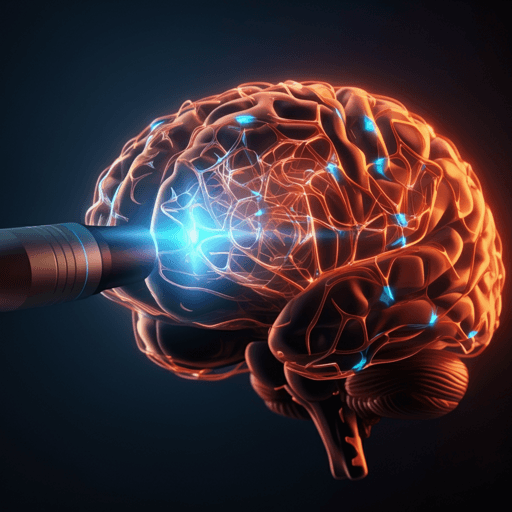
Psychology
Characterization of neural networks involved in transdiagnostic emotion dysregulation from a pilot randomized controlled trial of a neurostimulation-enhanced behavioral intervention
A. D. Neacsiu, N. Gerlus, et al.
Emotional dysregulation was probed with fMRI as adults used personalized autobiographical stressors and cognitive restructuring; results pointed to vmPFC–amygdala hyperactivity, altered frontoparietal engagement, and promising connectivity changes after a single session of cognitive restructuring paired with active neurostimulation over dlPFC. Research conducted by Andrada D. Neacsiu, Nimesha Gerlus, John L. Graner, Lysianne Beynel, Moria J. Smoski, and Kevin S. LaBar.
~3 min • Beginner • English
Introduction
The study investigates neural mechanisms of emotion regulation and dysregulation in a transdiagnostic clinical adult sample with high Difficulties in Emotion Regulation (DERS) scores. Drawing on prior work, cognitively mediated emotion regulation (especially cognitive reappraisal) typically engages a fronto-limbic network (dlPFC, vlPFC, dmPFC, frontal pole, amygdala, insula, mPFC, OFC) and reduces limbic/paralimbic activity. Clinical populations often show hypoactivation in prefrontal regions and hyperactivation in limbic areas (e.g., insula, amygdala), with vmPFC hyperactivation noted in depression. Cognitive restructuring (CR), a clinical reappraisal-based intervention, can be enhanced by noninvasive neurostimulation (e.g., rTMS). Using autobiographical memories to induce affect provides ecological validity and engages relevant neural circuits. Aims: (1) Characterize brain circuitry for emotion regulation and dysregulation at baseline, focusing on activation in amygdala, insula, dlPFC, dmPFC, vlPFC, vmPFC, OFC, and their functional connectivity. Hypotheses: 1a) DERS would negatively correlate with prefrontal activation and positively with amygdala/insula activation; 1b) dlPFC–amygdala connectivity would be significant during regulation and associate with effective regulation; additional exploratory connectivity among limbic and prefrontal ROIs and dlPFC–prefrontal connectivity were examined. (2) Exploratorily assess brain and behavioral effects of a one-time TMS-CR intervention: expecting greater distress reduction (SUDS) during regulation in active vs sham (2a), higher prefrontal activation during regulation in active vs sham (2b), and increased amygdala–dlPFC connectivity in active vs sham (2c), alongside whole-brain and ROI connectivity differences and neural markers of DERS improvement.
Literature Review
Non-clinical emotion regulation via reappraisal engages a distributed fronto-limbic network including dlPFC, vlPFC, dmPFC, mPFC/OFC, amygdala, and insula, reflecting increased prefrontal engagement with reduced limbic/paralimbic reactivity. Clinical samples with mood and anxiety disorders often show PFC hypoactivation (dlPFC, vlPFC, dmPFC) and limbic/paralimbic hyperactivation (anterior insula), with vmPFC hyperactivation during regulation in depression; amygdala hyperactivity and ACC/parietal hypoactivity can be disorder-specific. Autobiographical memory paradigms reliably induce affect and show PFC, insula, and amygdala involvement; depressed adults show elevated amygdala activity and greater amygdala–hippocampal connectivity during unregulated memories. CR is a core psychotherapy skill; neurostimulation (e.g., rTMS) can augment reappraisal effects, especially when activity is directed during stimulation. Prior meta-analyses and studies emphasize frontoparietal network contributions, insula’s role in integrating interoceptive/emotional signals, and prefrontal–amygdala coupling during regulation.
Methodology
Design: Pre-registered, randomized, double-blind, placebo-controlled pilot trial (NCT02573246) combining a single-session cognitive restructuring (CR) intervention with concurrent active or sham rTMS targeting left dlPFC, with fMRI assessments at baseline and follow-up. Participants: Adults aged 18–65 with ≥1 DSM-5 diagnosis (SCID-5), DERS ≥89, English-speaking, and able to participate. Exclusions included current substance/alcohol abuse, history of mania/psychosis, current/planned CBT, immediate hospitalization needs, high suicide risk, neuromodulation seizure risk, MRI contraindications, pregnancy, homelessness, inability to travel, or low verbal IQ. Stratification by CR proficiency (ERQ reappraisal) at intake. Sample: Baseline MRI n=36; after motion/exclusions, baseline analyses n=33 (6 men, 27 women; mean age 34.15, SD 13.74; mean DERS 111.15, SD 17.75). Follow-up MRI completed by n=25; valid pre-post MRI and behavioral data n=23 (active rTMS n=10; sham n=13). Procedures: Participants identified ten negative and four neutral autobiographical memories with ratings (valence, arousal, vividness, rehearsal, age) using abbreviated AMQ and created cue words for fMRI retrieval. Over ~1 month: baseline MRI (~120 min), rTMS-CR intervention (~3.5 h), follow-up MRI; weekly calls and one-month follow-up assessment. CR training included reframing and distancing; during intervention, CR was practiced on personalized stressors with 10 Hz rTMS over personalized left dlPFC target (based on baseline fMRI). Imaging: MRIQC quality checks; preprocessing via fMRIPrep 1.1.1. Acquisition: T1-weighted anatomical (3D EPI sequence, matrix 256×256, TR 2300 ms, TE 3.2 ms, FOV 256 mm², voxel 1×1×1 mm, 162 slices). Functional EPI (oblique axial; matrix 128×128, TR 2000 ms, TE 30 ms, FOV 256×256 mm², voxel 2×2×2 mm). Runs 1/3: 240 vols; runs 2/4: 216 vols. Task: 42 trials total across four runs. Each trial: fixation (6–10 s), arrow direction task (9 s), autobiographical memory cue (5 s), strategy word (Feel, Distance, Reframe; 10 s), SUDS rating (0–9; two-step via button box; 10 s). Blocks per run: feel_negative, feel_neutral, distance_negative, reframe_negative; pseudo-randomized; memories not repeated within a run. Analysis: First-level GLMs per run in FSL FEAT; regressors convolved with double-gamma HRF; main contrast Restructure (Distance+Reframe) > Feel Negative. Second-level fixed-effects averaging runs per participant; third-level mixed-effects (FLAME 1) group models at baseline and follow-up. Thresholding: voxel-wise z=2.3; cluster-wise FWE α<0.05; then Benjamini–Hochberg FDR q=0.10 across integrated results. Pre-post change modeled via paired-difference mixed-effects; group (active vs sham) differences in change examined; DERS change (baseline – 1 week) mean-centered included as covariate. ROI definitions: Brainnetome Atlas ROIs for dlPFC, dmPFC, vlPFC, vmPFC, OFC, amygdala, insula; AFNI 3dmask used to repair masks; participant-specific intensity-based masks applied. If whole-brain lacked ROI findings, FSL featquery extracted parameter estimates from 6-mm spheres centered on peak voxels. Connectivity: Generalized PPI (gPPI) with functional ROIs (fROIs) derived from significant BOLD activation (z>2.3) within anatomical ROIs, requiring ≥10% participant overlap; seeds: left/right dlPFC, amygdala, insula; third-level gPPI with voxel-wise z=2.3, FWE α<0.05; FDR corrections applied. Statistics: SPSS v25 with FDR q=0.10 across Aims; MMANOVA for behavioral SUDS changes using autoregressive covariance; covariates included AMQ valence/arousal/vividness (selected via regression), baseline SUDS and ERQ reappraisal.
Key Findings
Baseline activation during Restructure > Feel Negative showed increased activation in bilateral dlPFC and dmPFC, left inferior parietal cortex, and TPJ; decreased activation in bilateral SMA, bilateral insula, right midcingulate cortex, right vlPFC, and left posterior cingulate. Amygdala activation during regulation was significant in ROI analysis (mean peak = 0.15, SD 0.11; t(30)=7.09; PFDR=0.0016). Correlations at intake: Right vmPFC activation during regulation correlated with higher DERS total (r=0.589, PFDR=0.0058) and limited access to strategies (r=0.495, PFDR=0.0103), and negatively with reappraisal proficiency (r=-0.536, PFDR=0.0081). Left amygdala activation correlated with higher DERS (r=0.485, PFDR=0.0111), limited strategies (r=0.583, PFDR=0.0067), and difficulty engaging in goal-directed behavior (r=0.449, PFDR=0.0131). Baseline connectivity: Significant dlPFC–amygdala connectivity during regulation (M=0.23, SD 0.19; t(32)=6.69; PFDR=0.0020). gPPI: right insula seed connected with left midcingulate cortex (Zmax=3.97; PFDR=0.0044). ROI-to-ROI connectivity positively correlated with dysregulation: left insula–right dlPFC (DERS r=0.574, PFDR=0.0062; limited strategies r=0.584, PFDR=0.0059; goal-directed difficulties r=0.517, PFDR=0.0090), right insula–right vlPFC (DERS r=0.498, PFDR=0.0101; limited strategies r=0.569, PFDR=0.0065), right amygdala–right OFC (DERS r=0.435, PFDR=0.0132; limited strategies r=0.424, PFDR=0.0142; impulse control difficulties r=0.450, PFDR=0.0123). Reappraisal proficiency negatively correlated with multiple PFC–PFC and insula–OFC/vmPFC connections (e.g., bilateral dlPFC–left OFC r=-0.498, PFDR=0.0117; right dlPFC–left dlPFC r=-0.508, PFDR=0.0100; right insula–left OFC r=-0.473, PFDR=0.0112; left insula–right vmPFC r=-0.430, PFDR=0.0145; right dlPFC–left vlPFC r=-0.436, PFDR=0.0139). Emotion regulation self-efficacy negatively correlated with right insula–left OFC (r=-0.459, PFDR=0.0126) and right dlPFC–left dmPFC (r=-0.450, PFDR=0.0140). Follow-up activation changes: No significant group differences in activation changes; improved reappraisal proficiency correlated with lower right OFC activity (r=-0.640, PFDR=0.0107). Follow-up connectivity changes: Active vs sham showed greater increases in connectivity between right occipital cortex and right insula (seed; Zmax=3.28; PFDR=0.0093) and between right occipital cortex and left dlPFC (seed; Zmax=3.73; PFDR=0.0118). ROI-to-ROI: active > sham increases in right dlPFC–right OFC (t(21)=3.22; PFDR=0.0106) and left dlPFC–left insula (t(21)=2.75; PFDR=0.0137). Across all participants, increased right amygdala–left anterior insula connectivity at follow-up vs baseline (Zmax=3.58; PFDR=0.0089). Behavioral outcomes: At follow-up, excluding trials with non-arousing memories (SUDS feel ≤1), active rTMS produced greater SUDS reduction during regulation vs feel than sham (MMANOVA F[1,140.66]=11.42; p<0.00094; PFDR=0.0073). Estimated marginal means: delta SUDS active = 1.96 (SE 0.18) vs sham = 1.32 (SE 0.19); d=0.36. No tactic difference (F[1,208.67]=0.25; p=0.62). Predictors of follow-up regulation success: baseline SUDS (PE=0.27, SE=0.05; PFDR=0.0033), neutral memory ratings (PE=-0.54, SE=0.10; PFDR=0.0037), baseline ERQ reappraisal (PE=0.39, SE=0.07; PFDR=0.0036). Intervention-related DERS improvement: group×session×DERS change interactions showed, in active vs sham, greater DERS improvement associated with decreased left vlPFC (454 voxels; Zmax=4.47; PFDR=0.0053) and left superior temporal gyrus activation (294 voxels; Zmax=3.84; PFDR=0.0114), decreased right dlPFC–left inferior parietal lobule connectivity (319 voxels; Zmax=3.19; PFDR=0.0097), and increased right OFC–left cerebellum connectivity (341 voxels; Zmax=4.09; PFDR=0.0087).
Discussion
Findings partially support the hypotheses: clinical adults with high dysregulation showed increased engagement of dorsal frontoparietal regions during reappraisal but reduced activation in right vlPFC and bilateral SMA compared to patterns often observed in healthy controls, suggesting insufficient synchronized relay between subcortical and prefrontal hubs implicated in strategy selection and implementation. Emotion dysregulation correlated with heightened vmPFC and amygdala activation and with specific connectivity patterns (e.g., insula–dlPFC/vlPFC, amygdala–OFC), pointing to over-involvement and inefficient recruitment of frontal regions and maladaptive salience network coupling as markers of dysregulation. Post-intervention, active rTMS enhanced behavioral regulation and selectively increased connectivity among visual cortex, insula, and dlPFC, potentially indicating improved integration of visual imagery with cognitive control during autobiographical memory regulation. Across participants, improvements in regulation were associated with strengthened insula–vlPFC and insula–dmPFC connectivity and reduced dlPFC–dmPFC coupling, suggesting increased efficiency and specialization in prefrontal–salience network interactions. The OFC emerged as a critical node: its hyperconnectivity with amygdala related to impulsivity under distress, while decreased OFC activation and increased dlPFC–OFC connectivity after intervention may reflect improved top-down modulation balancing implicit and explicit regulation. Overall, the results highlight insufficient neural specificity and aberrant frontal resource allocation during regulation as transdiagnostic markers and suggest modifiable targets via neuromodulatory augmentation of CR.
Conclusion
Targeted emotion dysregulation interventions can benefit from understanding distinct neural signatures across transdiagnostic adults. This pilot study identified markers including right dlPFC, left dmPFC, right OFC, and insula–vlPFC/dmPFC connectivity as relevant targets. Active rTMS paired with CR produced preliminary neural and behavioral improvements after a single session, indicating potential for enhancing regulation efficiency through modulation of dlPFC–OFC and dlPFC/insula circuits and integration with visual processing networks. Future work should involve larger samples, inclusion of non-clinical controls, and refined, neuroscience-driven protocols focusing on insula–vlPFC/dmPFC and dlPFC–OFC pathways to personalize interventions for emotional dysregulation.
Limitations
Small sample sizes in treatment arms limit statistical power and generalizability; absence of a non-clinical control group constrains direct clinical vs non-clinical comparisons; gender imbalance (predominantly female) may affect generalizability given potential gender differences in emotion regulation strategies and treatment-seeking; exclusion of alcohol use disorder may bias the sample; autobiographical memory stimuli, while ecologically valid, are less controlled and may introduce inter-participant variability.
Related Publications
Explore these studies to deepen your understanding of the subject.







